Kyoto, the ancient capital of Japan, is a city steeped in history and culture. With its serene temples, breathtaking scenery, and traditional architecture that has stood the test of time, it’s no wonder that Kyoto is one of the most popular tourist destinations in Japan.
Whether you’re interested in exploring Buddhist temples or indulging in Japanese cuisine, this city offers something like no other.
From hiking through lush bamboo groves to wandering through bustling markets filled with local delicacies, Kyoto offers an endless array of experiences waiting to be discovered.
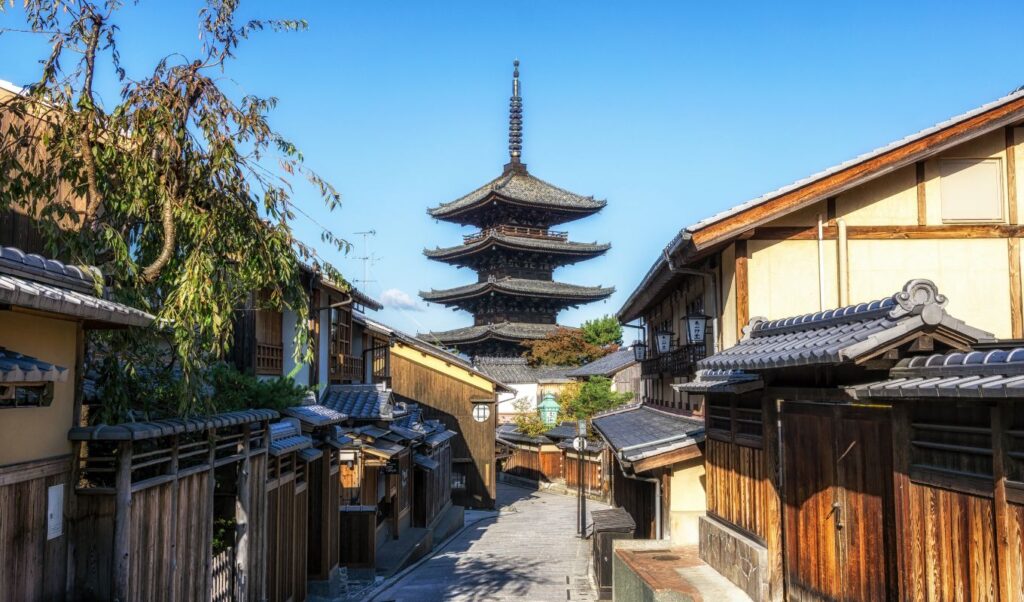
With so many options available to visitors, planning your itinerary can seem like a daunting task. To help make things easier for you we have compiled a list of must-see attractions and activities that will ensure you make the most out of your visit to this enchanting city.
Here we’ll take you on a journey through some of Kyoto’s top-rated sights including iconic landmarks such as Kinkakuji Temple (Golden Pavilion) and Fushimi Inari Shrine famous for its thousands of vermillion gates leading up Mount Inari.

We’ll also delve into lesser-known gems like Nishiki Market – known locally as “Kyoto’s Kitchen” – where vendors sell fresh produce and all manner of ingredients used in Japanese cooking making it food lover’s heaven; Arashiyama Bamboo Grove –a sprawling forest full towering bamboo stalks where nature enthusiast can experience peace amidst tranquil natural surroundings- are among our recommended places to visit while staying here.
Key Take Aways
- Pack light, but don’t forget comfortable shoes for all the walking you’ll do.
- Plan ahead to visit popular sites like Fushimi Inari Shrine in the early morning to avoid crowds.
- Try traditional Kaiseki cuisine at one of Kyoto’s many Michelin-starred restaurants.
- Rent a bicycle or join a bike tour to explore off-the-beaten-path neighborhoods and temples.
- Purchase an IC card like Suica or Pasmo for easy payment on trains, buses, and vending machines.
- Stay at a ryokan (traditional Japanese inn) for an authentic experience complete with tatami floors and futon beds.
- If traveling from Tokyo and Back ordering a JR Rail Pass prior to your trip can will save you money.
- Book accommodations early as Kyoto can get crowded during peak season.
- Try local dishes such as tofu kaiseki, tsukemono pickles, and wagashi sweets.
- An extensive bus network covers all major tourist sites within Kyoto: buys daily passes for convenience and cost savings.
- Don’t forget to soak in hot springs (onsen) after long days of sightseeing – many ryokans have private ones available only for guests’ use!
Cultural Experiences and Tour In Tokyo
Here are 8 amazing tours and attractions in Kyoto that you can book online
Kyoto Half-Day Private Walking Tour: Discover Kyoto’s top attractions, such as Kiyomizu-dera Temple, Fushimi Inari Shrine, and Gion District with a knowledgeable private guide on this personalized walking tour.
Kyoto Full-Day Sightseeing Tour: Explore the best of Kyoto on this full-day guided tour, visiting iconic sites like Nijo Castle, Kinkaku-ji Temple, and Arashiyama Bamboo Forest.
Arashiyama Bamboo Forest & Monkey Park Walking Tour: Enjoy a guided walking tour through the enchanting Arashiyama Bamboo Forest, and visit the Iwatayama Monkey Park for up-close encounters with Japanese macaques.
Kyoto Kimono Rental Experience: Immerse yourself in Japanese culture by renting a kimono and strolling through the historic streets of Kyoto dressed in traditional attire.
Kyoto Cooking Class: Learn to prepare authentic Japanese dishes under the guidance of a local chef, and enjoy your culinary creations in a cozy setting.
Kyoto Cultural Walking Tour with Tea Ceremony: Discover Kyoto’s rich history and culture on a guided walking tour, which includes a traditional Japanese tea ceremony experience.
Fushimi Inari Hidden Trail Hike: Explore the lesser-known trails of Fushimi Inari Shrine on a guided hike, discovering hidden spots and enjoying spectacular views of Kyoto.
Kyoto Samurai Experience: Learn about the history and techniques of Japan’s legendary samurai warriors in a hands-on workshop, including sword handling and a traditional samurai performance.
Choose from these tours and attractions to make your visit to Kyoto truly unforgettable, and delve into the rich history and culture of this ancient city.
A Brief History Of Kyoto

Kyoto, the ancient capital of Japan, has a rich history that dates back over 1200 years. Originally known as Heian-kyo, it was founded in 794 AD by Emperor Kammu to serve as his new imperial palace and administrative center.
During the Heian period (794-1185), Kyoto became the cultural heart of Japan. It was home to the nobility and aristocracy who developed refined aesthetics in art, literature, music and dance. Famous landmarks such as the Kiyomizu-dera Temple and Fushimi Inari Shrine were constructed during this time.
In 1185, however, Kyoto suffered a devastating blow when it was burnt down during a civil war between two powerful clans – the Taira and Minamoto. The city slowly recovered under military rule until 1336 when Ashikaga Takauji established himself as shogun with his base in Kyoto beginning an era called Muromachi period.

The following centuries saw many changes for Kyoto including wars involving different feudal lords who vied for control of its resources but also its prestige because of its status as Japan’s cultural capital.
During World War II, several parts of the city were destroyed including iconic buildings like Toji temple. However, after reconstruction efforts began on numerous historical sites like Ginkaku-Ji or Ryoan-Ji temples allowing visitors to enjoy their beauty once again.
Today Kyoto is still considered one of Japan’s most culturally rich cities with a unique blend of modernity and traditionalism attracting tourists from all over world–so much so that UNESCO declared seventeen historic monuments within city limits World Heritage Sites!
Things To Do In Kyoto

Whether you are interested in exploring old streets lined with wooden houses, and zen temples or immersing yourself in traditional Japanese cuisine and culture, there are bound to be many unforgettable experiences during your stay in Kyoto.
So let’s get into it. Here’s our very long list of the best things to do in Kyoto.
Note: Because there are so many attractions listed (47 and counting) we’ve kept the descriptions succinct, but it should be enough to help you choose where to visit during your stay.
Kinkaku-ji Temple (The Golden Pavilion)
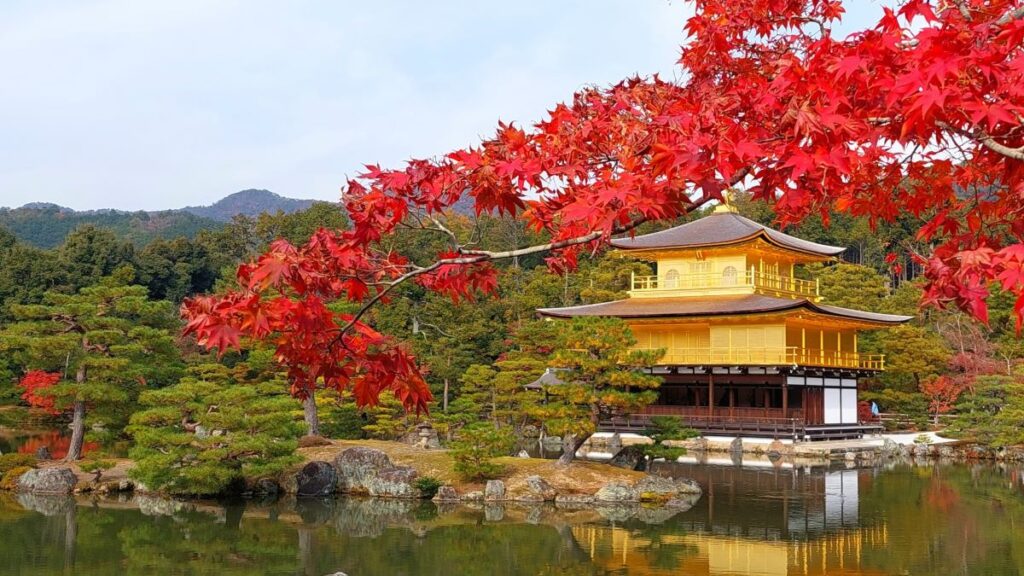
Kinkaku-ji, also known as the Golden Pavilion, is one of Kyoto’s most famous attractions. The temple is covered in gold leaf and sits on the edge of a tranquil pond, surrounded by trees and gardens. You can enter and walk around the temple grounds interior, which houses a statue of Buddha and relics.
Kinkaku-ji is particularly beautiful in the autumn when the leaves change color and the temple is reflected in the water.
Stroll Through Arashiyama

Arashiyama is a scenic district located on the western outskirts of Kyoto. The area is known for its bamboo groves, walking trails, and the iconic Togetsukyo Bridge. After taking a leisurely stroll along the river explore some great temples and shrines in the area, including Tenryu-ji and Jojakko-ji.
For a unique experience, take a ride on the Sagano Scenic Railway, which winds through the mountains and offers breathtaking views of the surrounding scenery.
Experience a Tea Ceremony
The Japanese tea ceremony, or chanoyu, is a traditional ritual that involves the preparation and serving of green tea to guests. The ceremony is deeply rooted in Japanese culture and is often associated with Zen Buddhism. Kyoto is the perfect place to give it a go at one of the many tea houses throughout the city. The ceremony typically lasts around 45 minutes and includes a small sweet snack along with the tea.
Explore Fushimi Inari-Taisha
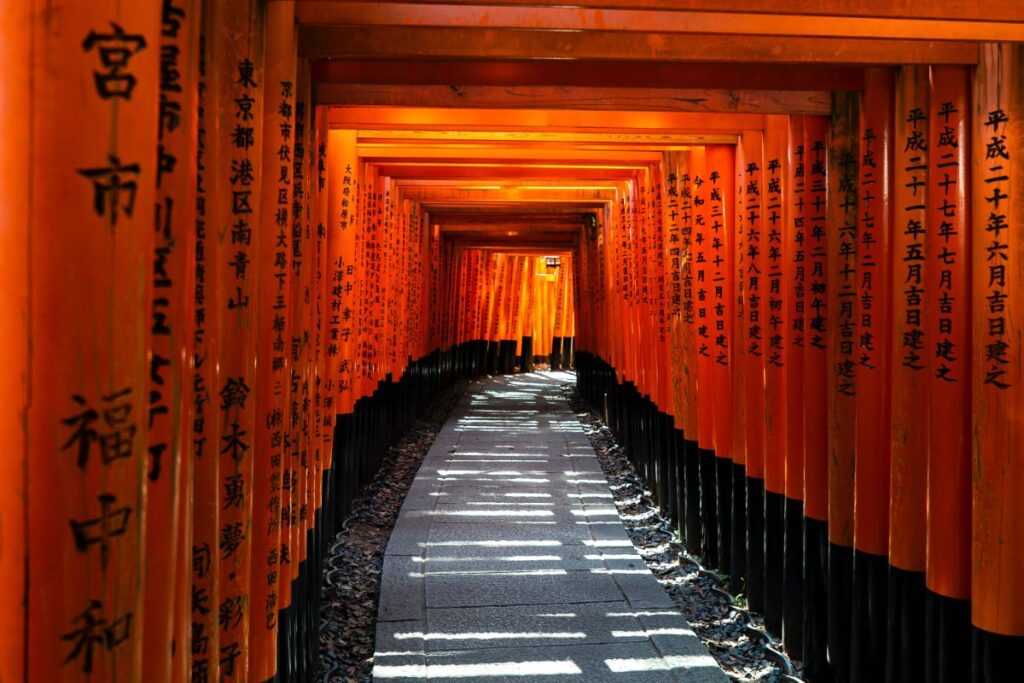
Another must-see attraction in Kyoto is the Fushimi Inari-Taisha Shrine. This shrine is dedicated to Inari, the god of rice and prosperity, and is known for its thousands of vermillion torii gates that line the paths leading up the mountain. The hike up the mountain takes around 2-3 hours, but the views of the city and the gates are well worth the effort.
Bring some comfy shoes and hike along the trails through the gates, which offer stunning views of the city and surrounding countryside. The further you head up the mountain the less crowded it gets, just make sure to leave enough time to get back before darkness falls.
Pro Tip: head to the shrine in the early morning before the crowds arrive.
Taste Kyoto Cuisine
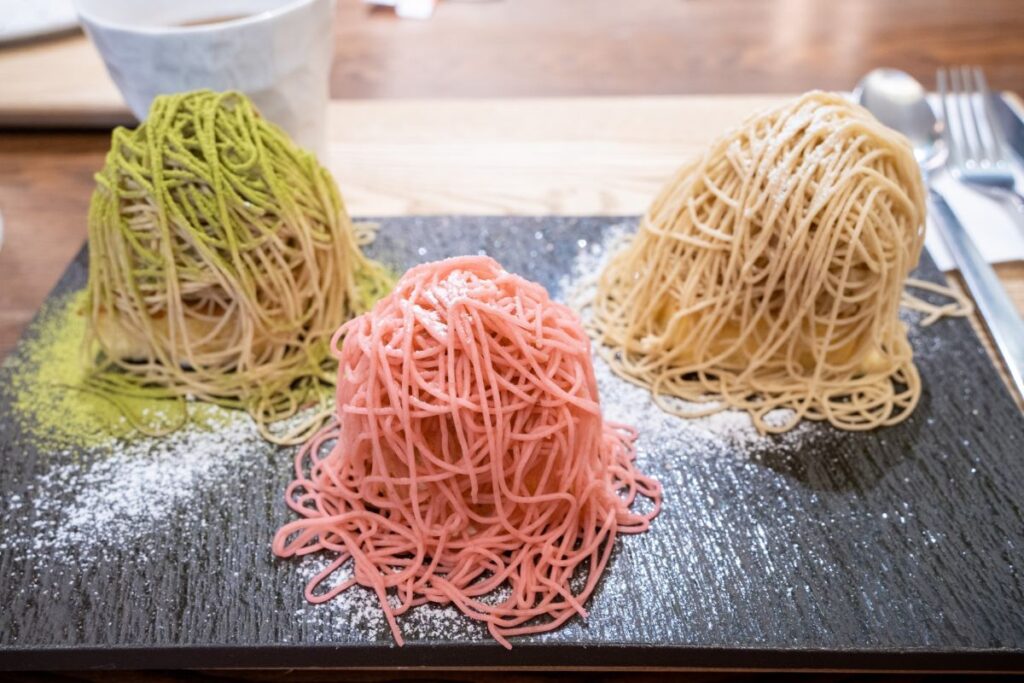
Kyoto is known for its unique cuisine, which includes a variety of traditional dishes and specialties. Try local delicacies like kaiseki ryori, a multi-course meal that features seasonal ingredients, or yudofu, a hot pot dish made with tofu. For a sweet treat, try some wagashi, traditional Japanese sweets that are often made with mochi and sweet red bean paste.
Visit Nijo Castle
Nijo Castle is a UNESCO World Heritage Site located in central Kyoto. The castle was built in the 17th century and served as the residence of the Tokugawa shoguns. Although the full castle no longer remains you can still explore the castle’s buildings, including the Ninomaru Palace, which features beautiful paintings on its sliding doors.
Nijo Castle is particularly famous for its “nightingale floors,” which squeak when walked on to alert the residents to the presence of intruders.
Take a Bike Tour
Kyoto is a city that’s perfect for exploring on two wheels. You can easily rent a bike and take a guided tour of the city’s sights, or venture out on your own. One popular route is the Philosopher’s Path, a scenic trail that runs along a canal and is lined with cherry trees.
Another great cycling route is following the riverside cycling road to Arashiyama, the Kamo River, and the Higashiyama district.
Gion Corner
Gion Corner is a cultural center located in the Gion district of Kyoto that is a great place to learn about traditional Japanese arts and performances, including tea ceremonies, flower arrangement, and the famous geisha dance.
Gion Corner also offers a glimpse into the geisha culture of Kyoto, with a display of traditional instruments and costumes. Performances are held several times a day, and tickets can be purchased in advance.
Relax at an Onsen
Onsens, or natural hot springs, are a beloved Japanese tradition. Kyoto is home to several onsens where you can relax and soak in warm mineral waters. One popular destination is Kurama Onsen, located in the scenic mountain town of Kurama. Catch a train or bus to the town and then hike to the onsen, which is surrounded by beautiful forest scenery.
Take a Cooking Class
Kyoto is known for its unique cuisine, so why not learn how to make them by taking a cooking class?
Classes typically involve a trip to a local market to select ingredients, followed by a hands-on lesson in preparing the dishes. Some classes also include a visit to a local tea house or sake brewery.
Explore the Kyoto International Manga Museum
The Kyoto International Manga Museum is a must-visit destination for any manga fan. The museum houses over 300,000 manga titles, as well as original artwork and manuscripts.
You can read manga in a variety of languages, attend workshops and events, and even create your own manga. The museum is in the historic district of Nakagyo-ku and is easily accessible by train or bus.
Visit the Kyoto Imperial Palace
The Kyoto Imperial Palace is the former residence of the Emperor of Japan. Here you can explore the traditional buildings and beautiful gardens on a guided tour, which provides insight into the history and culture of the imperial court. The palace is in central Kyoto and is surrounded by beautiful parks and gardens.
Shop at Nishiki Market
Nishiki Market is a bustling shopping street that’s been in operation for over 400 years. Drop by and sample local food and drink, including fresh seafood, pickles, and tea. The market is also home to interesting shops selling traditional crafts and souvenirs. The market is in the heart of downtown Kyoto making it easy to walk to.
Take a Day Trip to Nara
Nara is a historic city located about an hour’s train ride from Kyoto. Japan’s old capital is famous for the huge Todai-ji Temple and its giant bronze Buddha statue. Nara is also known for its friendly neighborhood deer, which roam freely through the city’s parks and streets.
Have A Cherry Blossom Viewing Part At Maruyama Park
Maruyama Park is one of Kyoto’s most popular spots for cherry blossom viewing. Head here in the springtime and stroll through the park’s expansive grounds to admire the beautiful pink blossoms, which bloom in late March or early April. The park is also home to a large weeping cherry tree, which is illuminated at night during the cherry blossom season.
Hike the Higashiyama Trail
if you need to work of some of that Ramen, the Higashiyama Trail awaits. This picturesque walking trail winds through the hills of eastern Kyoto so why not stroll along the trail and take in the stunning views of Kyoto and the surrounding countryside?
Being Kyoto, of course, the trail is lined with temples, shrines, and traditional buildings, making for a great double dose of nature and culture.
Relax in the Arashiyama Bamboo Grove
One of the most iconic views of Kyoto is mesmerizing Arashiyama Bamboo Grove, a tranquil oasis on the outskirts of Kyoto. Stroll along the picturesque paths and take in the serene beauty of the towering bamboo stalks. The grove is particularly stunning in the early morning or late afternoon when the sunlight filters through the leaves.
Okochi Sanso Villa
Nestled high in the Arashiyama hills, Okochi Sanso Villa is a breathtaking retreat from the bustle of Kyoto city. Its winding paths and lush gardens lead to panoramic views of cherry blossom trees and bamboo forests. The villa was built by famed actor Denjiro Okochi as his personal residence but now serves as a museum for visitors to appreciate its exquisite architecture and art collection.
Tofukuji Temple
The Tofukuji Temple is a stunning temple complex located in southeastern Kyoto. Visitors can explore the interesting buildings and gardens, which are designed in a traditional Zen style. The temple is particularly famous for its autumn foliage, which draws crowds of visitors from around the world.
Try the Kyoto-style Ramen
Ramen is a beloved Japanese dish that’s popular around the world, but Kyoto has its own unique style of ramen that’s not to be missed. Visitors can try the local specialty, which features a light, clear broth and delicate noodles. The toppings often include slices of tender pork, bamboo shoots, and green onions.
Experience the Gion Matsuri Festival

The Gion Matsuri Festival is one of Kyoto’s most famous cultural events. Held every July, the festival features elaborate parades, traditional music and dance performances, and colorful floats. if you are visiting in the summer you can experience the vibrant energy of this uniquely Japanese festival.
Kyocera Museum of Art
The Kyocera Museum of Art is a world-class institution that’s dedicated to contemporary art. Explore the various exhibits, which feature works by both Japanese and international artists. The museum is located in the heart of Kyoto and is easily accessible by train or bus.
Kiyomizu-Dera Temple

One of the most popular temples in Kyoto, Kiyomizu-Dera is a UNESCO World Heritage Site that dates back to 798 AD. The temple complex is located on a hillside and offers stunning views of the city below. Venture out on the famous wooden stage that juts out from the main hall, offering a unique perspective on the surrounding scenery.
Ginkaku-ji Temple (Silver Pavilion)

Another famous temple in Kyoto is the Ginkaku-ji Temple, also known as the Silver Pavilion. While it does not actually have any silver on it, the temple is known for its beautiful gardens and unique design. Visitors can enjoy the peaceful atmosphere and stroll through the garden’s mossy paths and scenic bridges.
Gion District

The Gion District is one of Kyoto’s most famous areas and is known for its traditional architecture, tea houses, and geisha culture. Spend time to explore the narrow streets and alleys of Gion and catch a glimpse of geisha and maiko (apprentice geisha) walking to their appointments.
Philosopher’s Path
The Philosopher’s Path is a peaceful walking trail that winds its way along a canal lined with cherry trees. The trail is named after the philosopher Nishida Kitaro, who used to walk along the path and contemplate his ideas. Visitors can take a leisurely stroll along the path and enjoy the seasonal beauty of the cherry blossoms in the spring or the vibrant foliage in the fall.
Kyoto Imperial Palace
The Kyoto Imperial Palace was once the residence of the Imperial family until the capital was moved to Tokyo. The palace features traditional Japanese architecture and gardens, making it a popular spot for history buffs and photographers. Visitors can take a guided tour of the palace and learn about the history of the Imperial family and the palace itself.
Kamogawa River
The Kamogawa River is a popular spot for locals and tourists alike, especially during the summer months. Visitors can walk along the riverbank or relax on the grassy banks and enjoy the views of the city and the river.
Nishiki Market
Nishiki Market is a bustling covered market in the heart of Kyoto. The market is known for its fresh seafood, produce, and traditional Japanese snacks. Visitors can wander through the narrow aisles and sample the local delicacies.
Cooking Class
Learn how to make traditional Japanese cuisine by taking a cooking class in Kyoto. Many cooking classes are taught by local chefs and offer a hands-on experience in preparing and cooking Japanese dishes.
Kyoto Botanical Garden
The Kyoto Botanical Garden is a peaceful oasis in the heart of the city. The garden features over 12,000 species of plants and is home to several historic greenhouses. Visitors can stroll through the gardens and enjoy the seasonal beauty of the flowers and foliage.
Eikan-do Temple
The Eikan-do Temple is a Buddhist temple that is known for its autumn foliage. The temple is located on a hillside and offers stunning views of the city and the surrounding mountains. Visitors can enjoy the colorful foliage in the fall and the peaceful atmosphere of the temple grounds.
Shorten-in Temple
The Shoren-in Temple is a historic temple that dates back to the 13th century. The temple features a beautiful garden and pond, making it a popular spot for photographers and nature lovers. Visitors can take a stroll through the garden and enjoy the tranquil atmosphere of the temple.
Yasaka Shrine
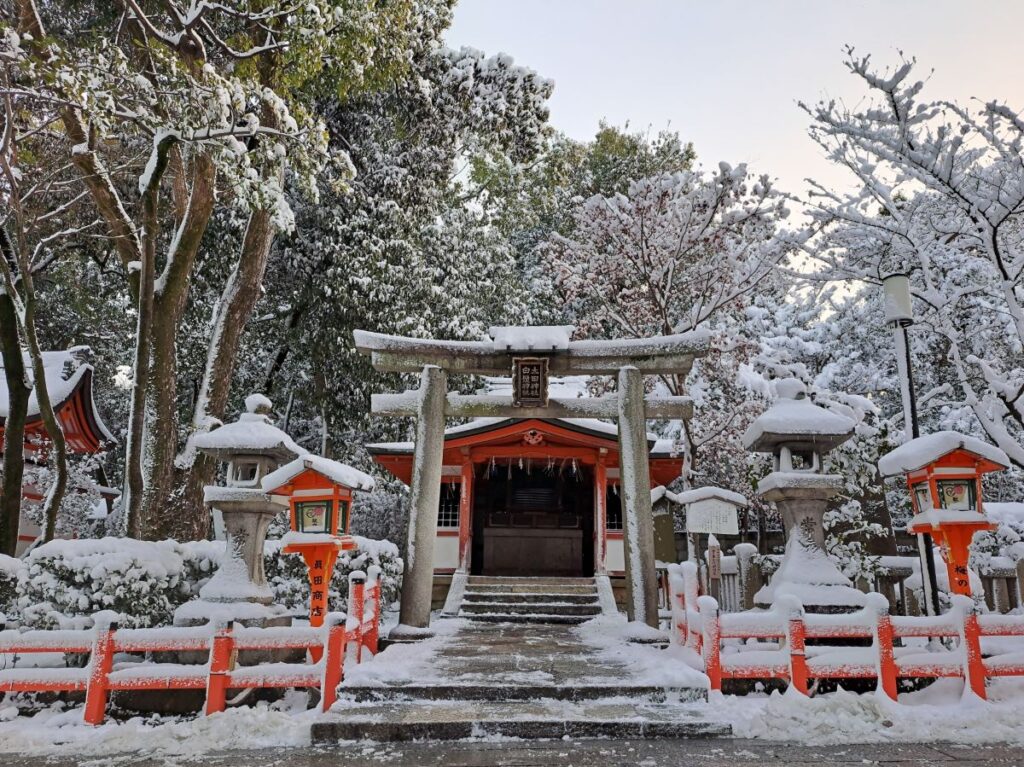
The Yasaka Shrine is a Shinto shrine that is located in the Gion district. The shrine is known for its festival, the Gion Matsuri, which takes place every July. The temple is open and free to enter and after dark, it is a great place for a night stroll after an evening meal in the Gion area.
Nanzen-ji Temple Complex
The Nanzen-ji Temple Complex is a large temple complex that is located in the eastern part of Kyoto. The complex features several temples, gardens, and historic buildings. Visitors can explore the grounds and learn about the history and significance of the temples and the complex as a whole.
Tenryu-ji Temple
The Tenryu-ji Temple is a UNESCO World Heritage Site that is located in the Arashiyama district of Kyoto. The temple is known for its beautiful gardens and scenic views of the surrounding mountains.
Toei Kyoto Studio Park
The Toei Kyoto Studio Park is a movie set that is open to the public. The park features several period buildings and sets, as well as costumes and props from popular Japanese movies and TV shows. You can even dress up in period costumes and take photos on the sets.
Ryoan-ji Temple
The Ryoan-ji Temple is a Buddhist temple that is known for its rock garden. The garden features 15 large rocks arranged in a unique pattern that is said to represent the essence of Zen Buddhism. It is a great place to sit and contemplate the garden or take a guided tour of the temple.
Hozu-gawa River Boat Ride
The Hozu-gawa River Boat Ride is a popular activity in Kyoto that offers stunning views of the surrounding mountains and scenery. The boat ride takes about two hours and passes through rapids and calm waters, making it an exciting and peaceful experience.
Nishijin Textile Center
The Nishijin Textile Center is a museum that showcases traditional Japanese textiles, including kimono fabrics and weaving techniques. Learn about the history and significance of the textiles and even try you hand at weaving on a traditional loom.
Kyoto Tower

The Kyoto Tower is a modern landmark in the city that offers stunning views of the surrounding area. Ttake an elevator to the top of the tower and enjoy the panoramic views from the observation deck.
Kyoto Railway Museum
The Kyoto Railway Museum is a museum that showcases the history and significance of trains in Japan. The museum features several historic trains and locomotives, as well as interactive exhibits and activities for visitors of all ages.
Tofuku-ji Temple
The Tofuku-ji Temple is a large temple complex that is known for its autumn foliage. The temple features several gardens and historic buildings, making it a popular spot for photographers and nature lovers. Enjoy the colorful foliage in the fall and the peaceful atmosphere of the temple year-round.
Sannenzaka and Ninenzaka Streets
The Sannenzaka and Ninenzaka Streets are two of Kyoto’s most famous streets and are known for their traditional architecture and shops. Wander through the narrow streets and alleys and browse the unique shops and restaurants.
Kitano Tenmangu Shrine
The Kitano Tenmangu Shrine is a Shinto shrine that is dedicated to the god of learning, Sugawara no Michizane. The shrine is known for its beautiful gardens and architecture and is a popular spot for students and scholars to pray for success in their studies.
Heian Shrine
The Heian Shrine is a Shinto shrine that is dedicated to the spirits of Emperor Kammu and Emperor Komei. The shrine is known for its large torii gate and beautiful gardens, making it a popular spot for photographers and nature lovers.
Kyoto National Museum
The Kyoto National Museum is a museum that showcases Japanese art and culture. The museum features several exhibits on Japanese painting, sculpture, and ceramics, as well as special exhibits throughout the year.
Sagano Scenic Railway
The Sagano Scenic Railway is a train ride that offers stunning views of the surrounding mountains and scenery. The train ride takes about 25 minutes and passes through several tunnels and over several bridges, making it an exciting and scenic experience.
Kyoto City Zoo
The Kyoto City Zoo is a popular attraction for families and animal lovers. The zoo features several animals, including pandas, elephants, and giraffes, as well as a petting zoo and playground.
Kyoto Aquarium
The Kyoto Aquarium is a modern aquarium that features several exhibits on marine life from around the world. The aquarium also has several interactive exhibits and activities, making it a fun and educational experience for visitors of all ages.
Shugakuin Imperial Villa
The Shugakuin Imperial Villa is a historic villa that was once the summer residence of the Imperial family. The villa features several traditional Japanese gardens and buildings, making it a popular spot for history buffs and photographers.
Kyoto Municipal Museum of Art
The Kyoto Municipal Museum of Art is a museum that showcases modern and contemporary art from Japan and around the world. The museum features several exhibits throughout the year and is a popular spot for art lovers and collectors.
Nijō-jō Castle
The Nijō-jō Castle is a historic castle that was built in the 17th century. The castle features several traditional Japanese buildings and gardens, as well as a moat and walls that are over 20 feet high.
Kyoto Handicraft Center
The Kyoto Handicraft Center is a museum and shop that showcases traditional Japanese crafts and handicraft techniques. Learn about the history and significance of Japanese crafts, as well as try making your own crafts under the guidance of experienced craftspeople.
Shimogamo Shrine
The Shimogamo Shrine is a UNESCO World Heritage Site that is dedicated to the gods of the Kamo family. The shrine is located in a wooded area and is known for its beautiful gardens and architecture. Explore the grounds of the shrine and learn about the history and significance of Shintoism.
Suntory Kyoto Brewery
The Suntory Kyoto Brewery is a brewery that produces several popular Japanese beers, including the famous Suntory beer. Take a tour of the brewery and learn about the brewing process, as well as sample some of the beers.
Kyoto City Museum
The Kyoto City Museum is a museum that showcases the history and culture of Kyoto. The museum features several exhibits on Kyoto’s history, including its role as the capital of Japan, as well as its art and culture.
Samurai Experience
Experience the life of a samurai by taking a samurai experience class in Kyoto. Visitors can dress up in traditional samurai clothing and learn about the history and culture of the samurai, as well as practice sword fighting techniques.
The Sum Up
Kyoto is undeniably a city worth visiting. From the rich historic sites to the more modern offerings, one can never run out of things to do in this beautiful Japanese city. Whether you are an art enthusiast wanting to explore the many galleries and museums or simply looking for a serene spot to meditate and connect with nature, Kyoto has it all.
Visitors who crave culinary adventure will find themselves spoiled for choice with numerous traditional restaurants serving up delicious local cuisine. And let’s not forget about the shopping! From street markets filled with unique souvenirs and rare finds to stylish boutiques showcasing contemporary fashion designs, there is no shortage of retail therapy options in Kyoto.
With so much on offer – temples galore, gardens aplenty – it’s easy to see why travelers keep coming back year after year.




